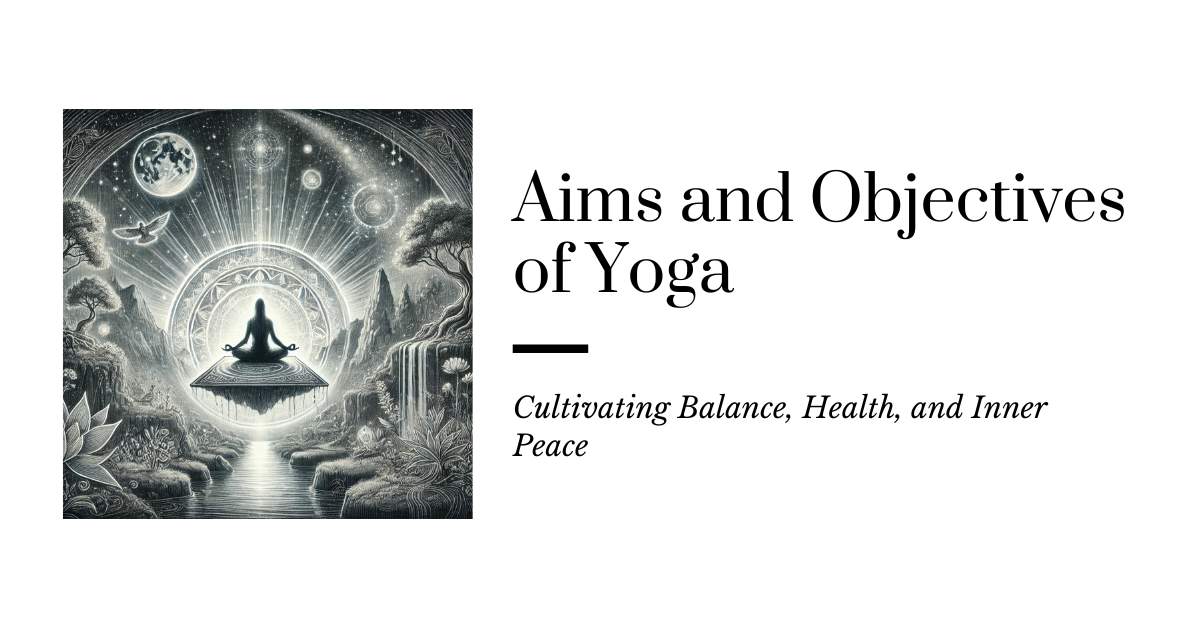Did you know that the primary aims and objectives of yoga are to achieve a harmonious balance between the mind, body, and spirit? Yoga, an ancient practice with roots in India, is more than just physical exercise. It’s a holistic system that integrates physical postures, breathing techniques, meditation, and ethical guidelines to promote overall well-being.
Let’s explore the fundamental aims and objectives of yoga and how they contribute to a balanced and fulfilling life.
What are the Aims of Yoga?
The aims of yoga are multi-dimensional, addressing different aspects of human existence. Here are the core aims of practicing yoga:
1. Physical Health and Fitness One of the most immediate and recognizable aims of yoga is to enhance physical health. Through various asanas (postures) and pranayama (breathing techniques), yoga helps:
- Increase flexibility and strength
- Improve posture and alignment
- Enhance circulation and respiratory function
- Reduce stress on the joints and muscles
Yoga also supports the body’s natural healing processes, making it a powerful tool for maintaining and restoring health.
2. Mental Clarity and Focus Yoga is designed to calm the mind and improve concentration. The practice encourages mindfulness, helping individuals:
- Reduce mental clutter and distractions
- Enhance cognitive function and memory
- Develop a calm and centered mind through meditation and focused breathing
By promoting mental clarity, yoga helps practitioners make better decisions, manage stress, and cultivate a positive mindset.
3. Emotional Balance Yoga aims to bring emotional stability and peace by teaching practitioners how to regulate their emotions. Through consistent practice, yoga can:
- Reduce anxiety and depression
- Promote emotional resilience and stress management
- Enhance self-awareness and understanding of one’s emotions
This emotional balance contributes to overall mental health and well-being, allowing individuals to navigate life’s challenges with greater ease.
4. Spiritual Growth For many, yoga is a spiritual practice that aims to connect the individual with a higher consciousness. This spiritual aspect of yoga is not tied to any specific religion but focuses on:
- Self-realization and understanding one’s true nature
- Experiencing inner peace and contentment
- Cultivating a sense of oneness with the universe
The spiritual aim of yoga is often achieved through meditation, ethical living (Yamas and Niyamas), and deep contemplation.
Read More: Finding the Best Yoga Mat: Why YOGA DESIGN LAB Might Be Your Perfect Match
What are the Objectives of Yoga?
The objectives of yoga are the specific goals that practitioners seek to achieve through regular practice. These objectives align with the broader aims of yoga and are as follows:
1. Attaining Physical Wellness The objective here is to develop a healthy, flexible, and strong body that can support the mind and spirit. Practitioners aim to:
- Master various asanas to improve physical health
- Practice pranayama to enhance lung capacity and oxygenate the body
- Adopt a balanced diet and lifestyle that complements their yoga practice
2. Cultivating Mental Discipline Yoga aims to train the mind to focus and remain calm even in challenging situations. Objectives include:
- Regular meditation practice to improve concentration
- Mindfulness techniques to stay present and aware
- Developing patience and reducing impulsive reactions
3. Achieving Emotional Stability Yoga helps individuals manage their emotions effectively, with objectives such as:
- Practicing compassion and empathy towards oneself and others
- Reducing negative emotions like anger, jealousy, and fear
- Building emotional resilience to handle life’s ups and downs
4. Fostering Spiritual Awareness The spiritual objectives of yoga are about connecting with the self and the universe. Practitioners aim to:
- Explore inner consciousness through meditation and introspection
- Live in harmony with nature and the world around them
- Experience spiritual growth and a deeper understanding of life’s purpose
Aims and Objectives According to Scriptures
Yoga Sutras of Patanjali:
- Contains 196 aphorisms on the theory and practice of yoga.
- Introduces Ashtanga Yoga (eight limbs of yoga), which includes:
- Ethical precepts (Yama and Niyama)
- Physical postures (Asana)
- Breath control (Pranayama)
- Sensory withdrawal (Pratyahara)
- Concentration (Dharana)
- Meditation (Dhyana)
- Absorption (Samadhi)
Bhagavad Gita:
- Part of the Mahabharata, featuring a dialogue between Prince Arjuna and Lord Krishna.
- Addresses moral dilemmas and the paths of yoga, including:
- Karma Yoga (yoga of action)
- Bhakti Yoga (yoga of devotion)
- Emphasizes selfless action and the importance of duty.
Upanishads:
- Explores the nature of reality and the self.
- Discusses meditation and the goal of realizing one’s unity with Brahman (ultimate reality).
- The Yoga Upanishads focus specifically on yoga practices and principles.
Hatha Yoga Pradipika:
- Written in the 15th century as a comprehensive guide to Hatha Yoga.
- Details postures, breathing techniques, and the importance of physical and mental purification.
Vedas:
- The oldest sacred texts of Hinduism.
- Outline various aspects of life, including yoga and meditation as paths to spiritual growth and inner peace.
Shiva Samhita:
- Discusses the philosophy and practice of yoga.
- Emphasizes the importance of meditation and the role of the guru in guiding the practitioner.

Embracing the Aims and Objectives of Yoga
The practice of yoga is a journey towards achieving a harmonious balance between the physical, mental, emotional, and spiritual aspects of life. By understanding and embracing the aims and objectives of yoga, practitioners can lead a more balanced, healthy, and fulfilling life.
Whether you’re looking to improve your physical health, calm your mind, or explore deeper spiritual truths, yoga offers a path that can guide you towards achieving your goals. Start your yoga journey today and discover the transformative power it holds.
Read More: Yoga Score Sheet: Tracking Your Progress To Get Results!
